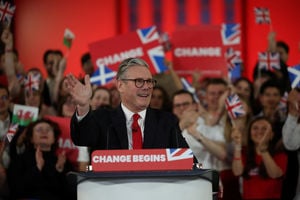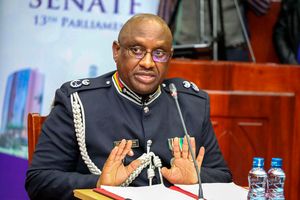Let Ruto, Raila talks be about Kenya

President William Ruto (left) retired Nigerian President Olusegun Obasanjo and opposition leader Raila Odinga.
Under ordinary circumstances, it should be good news that President William Ruto and opposition leader Raila Odinga have met and agreed on a framework for talks.
A team to take over where the bipartisan parliamentary committee failed should lead to a respite from the public protests that caused so much destruction and death. Easing of fears that Kenya was on the verge of tipping over into civil strife should, in turn, lead to public confidence in efforts to build a broken economy.
It is troubling, however, that recriminations were put on public display even before the ink had dried on the deal brokered by former Nigerian President Olusegun Obasanjo. Instead of a joint statement, President Ruto’s Kenya Kwanza Alliance and Mr Odinga’s Azimio la Umoja One Kenya Coalition Party released competing versions of the agenda for the proposed talks.
Long-standing divides
Most notably, in the Ruto team’s version, the two most critical issues, the cost of living and an audit of the 2022 presidential election results, were not on the table.
But even if those issues were to be included, the overall agenda suggest little or nothing towards resolution of the long-standing divides that in every election cycle push Kenya to the edge. If issues of good governance, human rights, equitable development, social justice and respect for the Constitution are not up for discussion, then the talks are nothing but negotiations for the benefit and interests of the political classes.
The entire architecture of talks limited to representatives of Dr Ruto and Mr Odinga can only be designed to result in outcomes around who wallows in the feeding trough. What Kenya needs is a national conversation, not haggling between the political elite.
For any dialogue to be meaningful, it must, at a bare minimum, extend beyond the self-interest of political formations and incorporate wider stakeholders. The civil society, citizen groups, religious leadership, workers, trade and industry associations, professional bodies and others should be at the table.
If, indeed, the dialogue is to proceed as, essentially, haggling between President Ruto and Mr Odinga, then we must recognise that it will only result in temporary truce. This is not to say that a respite from the violent demonstrations and murderous police reaction would not be welcome. We all need the peace to get on with humdrum daily existence free of stone-throwing mobs and police teargas and bullets.
Deep chasms
But we will then need another dialogue mechanism to take a look at the real fissures in society that may be beyond the understanding of politicians only interested in the here and now. We have deep chasms that neither the transition to multi-partyism nor adoption of the 2010 Constitution resolved.
There was an attempt at having a fresh look at the national divide with the ill-fated Building Bridges Initiative (BBI) driven by then-President Uhuru Kenyatta and Mr Odinga between 2018 and 2021.
BBI was a noble and forward-looking proposal. But it was bound to self-implode once the founding ideals were subsumed under the weight of political wheeling and dealing.
Now is the time to revisit the key issues identified then and find how they can be put back on the table. If the Ruto-Raila tango will not have room to address them, there is no reason why the citizens outside the parasitic classes cannot launch their own national dialogue.
There are precedents where the coming together of the people themselves has head great effect in forcing elected leaders to play catch-up. The sustained pressure going back to the mid 1990s that led to the 2010 Constitution is a case in point. That can be the model to recreate.
* * *
President Ruto was the other day resplendent in a designer weed shirt, one emblazoned with the unmistakable motifs of the marijuana plant.
This, incidentally, is not the first time Dr Ruto has implicitly endorsed weed. During the period he was driving his presidential campaign from the comforts of the official residence of Deputy President in 1990, he flagged off a fleet of matatus he had accorded some favour, and his media team distributed photographs of him riding in one emblazoned with the leaf.
I pointed it out to him at the time that he might be seen to have joined the ‘Legalise it’ campaign. He didn’t see it that way, suggesting that the motif on the matatu was of no concern. It is.
Once might be an innocent error but twice might be taken as a clear signal. Would he, for example, sport the rainbow symbol of the gay rights campaign because he thinks it looks pretty on him?
[email protected]. @MachariaGaitho





